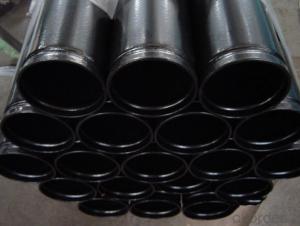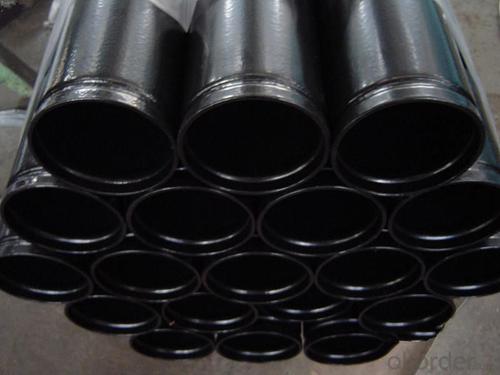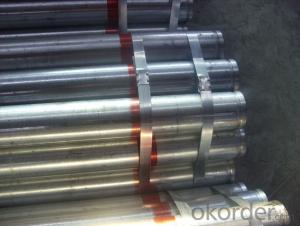black painted seamless grooved pipe for fire fighting
- Loading Port:
- China Main Port
- Payment Terms:
- TT OR LC
- Min Order Qty:
- -
- Supply Capability:
- -
OKorder Service Pledge
OKorder Financial Service
You Might Also Like
Our company is specialized in the supply of Hot Dipped Galvanized Pipes. We supply stee pipesl with very competitive price to meet customers' needs with the satisfied service and high standard quality.
Name | galvanized pipe with the standard quality |
Material | Q195, Q215, Q235, Q345, STK500 |
Specification | O.D.: 20- 273.1MM W.T.: 0.8 - 5mm |
Length | 5.8m, 6m, 11.8m or 12m, or per the buyers demand |
Surface treatment | Oil-dip, Varnish, Passivation, Phosphating, Shot Blasting. |
Certificates | BS1387-1985, DIN2440/2441, JIS-G3444 and ASTM |
Manufacture Technique | Seamless |
Section Shape | Round |
End | A): GTC (galvanized threaded and coupling) |
Weight | Billing on the basis of theoretical weight |
Packaging Details | Export packing or negotiation |
Trade Terms | FOB/CFR/CIF |
Payment Terms | L/C T/T |
Usage | Petroleum casing pipe/etroleum cracking pipe/gas cylinder tubes/highpressure boiler tubes/ high pressure chemical fertilizer pipe, ship tube |
Delivery Time | 7-30 days OR upon the negotation |
Minimum Order Quantity | 20/50/100 MT |
Supply Ability | 1000 Ton/Month |
Inspection | Chemical Composition Inspection, Mechanical Properties Test(Tensile Strength,Yield Strength, Elongation, Flaring, Flattening, Bending, Hardness, Impact Test), Surface and Dimension Test,No-destructive Test, Hydrostatic Test. |
- Q: How does the price of steel pipes vary based on size and grade?
- The price of steel pipes can vary based on their size and grade. Generally, larger pipes tend to have higher prices due to the increased amount of raw materials required for their production. Additionally, pipes with higher-grade steel, which offers better strength and durability, often come at a higher cost compared to lower-grade options. The size and grade of steel pipes are important factors to consider when determining their price in the market.
- Q: How to descaling galvanized steel pipe?
- Galvanized steel tubes will not rust in principle.... Batch rust with weak acid water immersion, individual can use steel wire brush brush on it.
- Q: What are the factors to consider when designing a steel pipe system?
- When designing a steel pipe system, several factors need to be considered. Firstly, the intended purpose of the system and the materials that will be transported through it are crucial. This determines the required pipe diameter, thickness, and material type to ensure compatibility and prevent corrosion or leakage. Secondly, the operating conditions, such as temperature, pressure, and flow rate, must be examined to select pipes with suitable strength and resistance properties. Additionally, factors like environmental conditions, including soil characteristics and exposure to chemicals or natural elements, should be evaluated to determine the necessary protective coatings or insulation. Lastly, considerations like installation requirements, regulatory compliance, and maintenance accessibility should be taken into account to design a practical and efficient steel pipe system.
- Q: What is the impact of temperature on steel pipes?
- The impact of temperature on steel pipes is significant and can have both positive and negative effects. At high temperatures, steel pipes can experience thermal expansion, causing them to expand and potentially leading to distortion or buckling. This expansion can also affect the joints and connections, potentially causing leaks or failures. Therefore, it is crucial to consider the coefficient of thermal expansion when designing and installing steel pipes in high-temperature environments. On the other hand, steel pipes typically have excellent thermal conductivity, allowing them to withstand high temperatures without significant degradation. This makes them suitable for applications where heat transfer is a primary concern, such as in industrial processes or heating systems. Extreme cold temperatures can have detrimental effects on steel pipes as well. In freezing conditions, water or other fluids inside the pipes can expand and lead to cracks or bursts. This can cause leaks, loss of fluid, and potential damage to surrounding structures. Therefore, appropriate insulation and preventive measures need to be taken to ensure the integrity of steel pipes in cold environments. Additionally, temperature variations can also affect the mechanical properties of steel, such as its tensile strength and toughness. For instance, exposure to elevated temperatures over an extended period can lead to a phenomenon known as thermal degradation, where the steel's strength decreases, making it more prone to deformation or failure. In conclusion, the impact of temperature on steel pipes is significant and can influence their structural integrity, thermal performance, and mechanical properties. Proper design, insulation, and maintenance are essential to ensure the safe and efficient operation of steel pipes in various temperature conditions.
- Q: Can steel pipes be used for wastewater treatment facilities?
- Yes, steel pipes can be used for wastewater treatment facilities. Steel pipes are known for their durability, corrosion resistance, and high strength, which makes them suitable for handling various types of wastewater and harsh chemicals. Additionally, steel pipes can be easily welded, allowing for flexibility in design and installation.
- Q: What are the advantages of using steel pipes in construction?
- There are several advantages of using steel pipes in construction. Firstly, steel pipes are incredibly strong and durable, making them suitable for carrying heavy loads and withstanding extreme weather conditions. Secondly, steel pipes have a high resistance to corrosion, which ensures their longevity and minimizes maintenance costs. Additionally, steel pipes are versatile and can be easily customized to fit specific project requirements. Lastly, steel pipes are fire-resistant, making them a safer choice for construction purposes. Overall, the use of steel pipes in construction offers strength, durability, corrosion resistance, versatility, and fire safety.
- Q: Is the seamless steel pipe used in the market hot or cold drawn?
- Outside diameter 89, most are cold drawn, more than 89 hot rolling.
- Q: What are the advantages of using stainless steel pipes?
- There are several advantages of using stainless steel pipes. Firstly, stainless steel is highly resistant to corrosion, making it suitable for various applications where exposure to moisture or harsh environments is a concern. Secondly, stainless steel pipes have excellent strength and durability, allowing them to withstand high pressures and temperature fluctuations. Additionally, stainless steel is hygienic and easy to clean, making it ideal for applications in the food and beverage industry. Lastly, stainless steel pipes are aesthetically pleasing and can be easily integrated into different architectural designs.
- Q: What is the difference between steel pipe and aluminum pipe?
- Steel pipes and aluminum pipes differ primarily in their composition and physical properties. Steel pipes are composed of iron and carbon, with added elements for strength and corrosion resistance. In contrast, aluminum pipes are made entirely of lightweight and highly corrosion-resistant aluminum. The weight of the pipes is a significant distinction. Steel is denser than aluminum, making steel pipes heavier and more robust. This characteristic makes steel pipes ideal for applications requiring structural strength and load-bearing capabilities. On the other hand, aluminum pipes offer advantages due to their lightweight nature. They weigh only about one-third of steel pipes, making them easier to handle, transport, and install. This lightweight property is especially beneficial in industries such as aerospace and automotive, where weight reduction is crucial. Corrosion resistance is another important consideration. Steel pipes are prone to rust and corrosion, especially in moist or corrosive environments. To address this issue, steel pipes are often coated or galvanized. In contrast, aluminum pipes naturally resist corrosion due to the formation of a protective layer of aluminum oxide on their surface. Cost is also a factor to consider. Generally, steel pipes are more cost-effective due to lower raw material and manufacturing costs. However, long-term maintenance costs and lifespan may vary between steel and aluminum pipes, so specific requirements and durability should be taken into account. In conclusion, the difference between steel and aluminum pipes lies in their weight, strength, corrosion resistance, and cost. Steel pipes are heavier, stronger, and more prone to rust and corrosion but are generally more cost-effective. Aluminum pipes are lightweight, corrosion-resistant, and costlier but offer advantages in weight reduction and specific applications requiring corrosion resistance. The choice between steel and aluminum pipes depends on the project's needs and desired properties for optimal performance.
- Q: Can stainless steel pipes spray black paint?
- Stainless steel pipes can spray black paint.The stainless steel surface with a layer of smooth surface, so the painting before the need to use corner grinder or iron brush to paint out into hair and then paint. Otherwise, spray paint can not be adhered to the surface of the stainless steel pipe.
Send your message to us
black painted seamless grooved pipe for fire fighting
- Loading Port:
- China Main Port
- Payment Terms:
- TT OR LC
- Min Order Qty:
- -
- Supply Capability:
- -
OKorder Service Pledge
OKorder Financial Service
Similar products
Hot products
Hot Searches
Related keywords
























